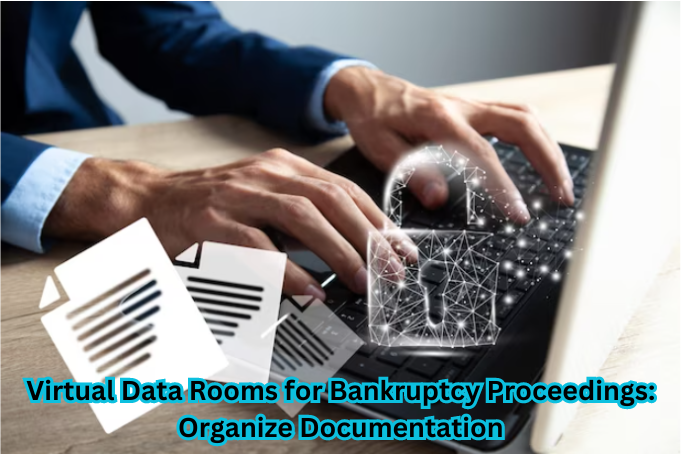It is crucial to efficiently organize and manage paperwork in the complicated world of bankruptcy procedures. The need for a safe and well-organized data repository cannot be emphasized enough as companies navigate the difficult bankruptcy process. Here is where VDRs shine as a revolutionary tool. In this essay, we will delve into the revolutionary function of a virtual data room in bankruptcy proceedings, explaining its advantages and how it simplifies the complex paperwork procedure.
Realizing the Benefits of a Virtual Data Room
1. Bringing Order to the Documentation Maze
Paperwork may pile up fast when you’re in the middle of a bankruptcy case. With virtual data rooms, all relevant papers can be housed in one convenient location, ensuring that critical information is easily accessible and structured. Having all your documents in one place helps keep your workflow organized and ensures that no important facts are missed, whether they be financial records or legal paperwork.
2. Strengthened Safety Protocols
Extreme caution is required because of the sensitive nature of the material involved in bankruptcy procedures. Protect sensitive information in a virtual data room with strong encryption and access controls. Because of this, stakeholders are reassured that their information is safe and secure, and sensitive data is likewise protected.
3. Collaborative Efficiency
The success of a bankruptcy case relies on the teamwork of all parties involved, including creditors, attorneys, and financial counselors. Authorized users may access and edit documents in real time in a virtual data room, facilitating seamless collaboration. This promotes openness, which is essential when dealing with the intricacies of bankruptcy and speeds up the decision-making process.

Methods for Optimizing Bankruptcy Virtual Data Rooms for Search Engine Optimization
4. Incorporating Keywords: A Craft, Not a Science
“Virtual data room for bankruptcy proceedings” is our target term, and we know how important it is, so we begin the careful integration process. Natural inclusion is the key, so keep that in mind. Even though keyword-rich material is better for search engines, it might make the piece hard to read if used excessively. Find that sweet spot where search engines and human readers can connect.
5. The Significance of Subheadings
With the help of subheadings, you can structure your information in a way that search engines adore. They do double duty as sections that are easy to read and as places to include keywords. To improve our search engine optimization (SEO), we should carefully emphasize the keywords within subheadings as we explore the details of virtual data rooms.
Exploring the World of Virtual Data Rooms
6. Managing Remotely and Accessible in Real Time
Having access to information in real time is essential in our digital age. Thanks to virtual data rooms intended for remote access, stakeholders may access and manage material from anywhere. In addition to speeding up the decision-making process, this also accounts for how bankruptcy procedures are always changing.
7. Efficient Auditing Made Easy
A virtual data room greatly streamlines the stringent auditing requirements of bankruptcy procedures. Thanks to the thorough audit trail, everything in the virtual data room is recorded and time-stamped. In the bankruptcy process, which is fraught with scrutiny, this guarantees responsibility and gives a complete record of document exchanges.
The Seamless Transition: From Chaos to Control
8. Transition Words: Your Guide through the Narrative
Using transition phrases strategically allows us to move fluidly through the bankruptcy procedures and understand the function of virtual data rooms. The use of transition words like ‘ over,’ ‘although,’ and ‘therefore’ makes the essay interesting and simple to follow, whether the author discusses the advantages of improved security or diving into collaboration efficiency.

9. A Journey of Transformation: From Anarchy to Mastery
Quietly maneuvering through a storm is a common metaphor for bankruptcy. Despite all this chaos, a virtual data room provides a guiding light. An otherwise daunting task becomes more doable and productive because of the journey-altering combination of systematic organization, improved security, and collaborative features.
Final Thoughts: Making the Most of Online Data Rooms
As bankruptcy procedures progress, the virtual data room plays an essential and game-changing role. The benefits are immense, and they range from improving security to reshaping document organization to increasing collaboration efficiency. Using a virtual data room is becoming more important for companies facing bankruptcy difficulties. They are paving the way for future efficiency and security by doing this and making sure that people have an easier time navigating the bankruptcy process.
Combined, a strategic keyword integration with a well-executed virtual data room provides a thorough roadmap for companies navigating the complex bankruptcy process. This goes beyond simple document management; it’s about utilizing technology to overcome obstacles and come out on top.
FAQ
Effective information management is critical in bankruptcy procedures’ complex and time-sensitive context. The Virtual Data Room (VDR) is a groundbreaking instrument that has changed the game in this industry. The necessity for an effective and safe document repository is greater than ever before as companies deal with the intricacies of financial reorganization and legal disputes.
What is the role of a virtual data room in an insolvency process?
For important documents to be safely stored and shared during bankruptcy, a Virtual Data Room (VDR) is a great tool to have on hand. Its function is multi-faceted, from assuring transparency among stakeholders to easing due diligence for possible investors. A VDR simplifies and secures the paperwork during the complex insolvency procedures.
How do you organize a virtual data room?
The correct way to organize a virtual data room is with a systematic strategy for handling documents. The first step is sorting the papers according to their significance, such as bank records, contracts, and legal documents. Use sensible naming standards and provide a transparent folder structure. In addition, use the VDR’s permission controls to restrict document access to approved users only. This systematic arrangement improves accessibility and simplifies the bankruptcy procedure as a whole.
What is the meaning of VDR?
Virtual Data Room is the acronym for the answer. In the event of a financial transaction, legal process, or, as is the case here, insolvency proceedings, this secure online repository can be used to store and share sensitive information. Businesses may exchange sensitive data with authorized parties using VDRs because of the extensive security features that allow them to regulate who has access to what.
What is the VDR process?
Numerous critical elements comprise the VDR process, which is the correct response. The insolvency procedures begin with uploading pertinent documents to the digital data room. Afterward, these papers are structured to make them easy to navigate. Access permissions are set up to restrict who can see or make changes to which documents. During bankruptcy, the VDR acts as a central location for secure due diligence, cooperation, and administration of important information.
Why is virtual data needed?
The answer is yes; there are several reasons why virtual data is so important in bankruptcy procedures. It lessens the likelihood of data breaches by providing a safe and centralized place to store important information. Stakeholders may perform due diligence easily with virtual data, which aids in decision-making. The parties participating in bankruptcy procedures can communicate openly and honestly thanks to the collaborative characteristics of virtual data rooms, which helps the processes go more smoothly.
What are the duties of insolvency?
A series of responsibilities meant to alleviate financial hardship and guarantee creditors’ fair treatment are involved in insolvency. Typical responsibilities include cataloging and valuing assets, creating a detailed repayment plan, and distributing assets to creditors. Honesty and following all regulations are of the utmost importance during this procedure. A virtual data room is a great tool for these tasks since it allows all parties participating in bankruptcy procedures to communicate more easily and securely while offering a platform for the structured management of documents.

